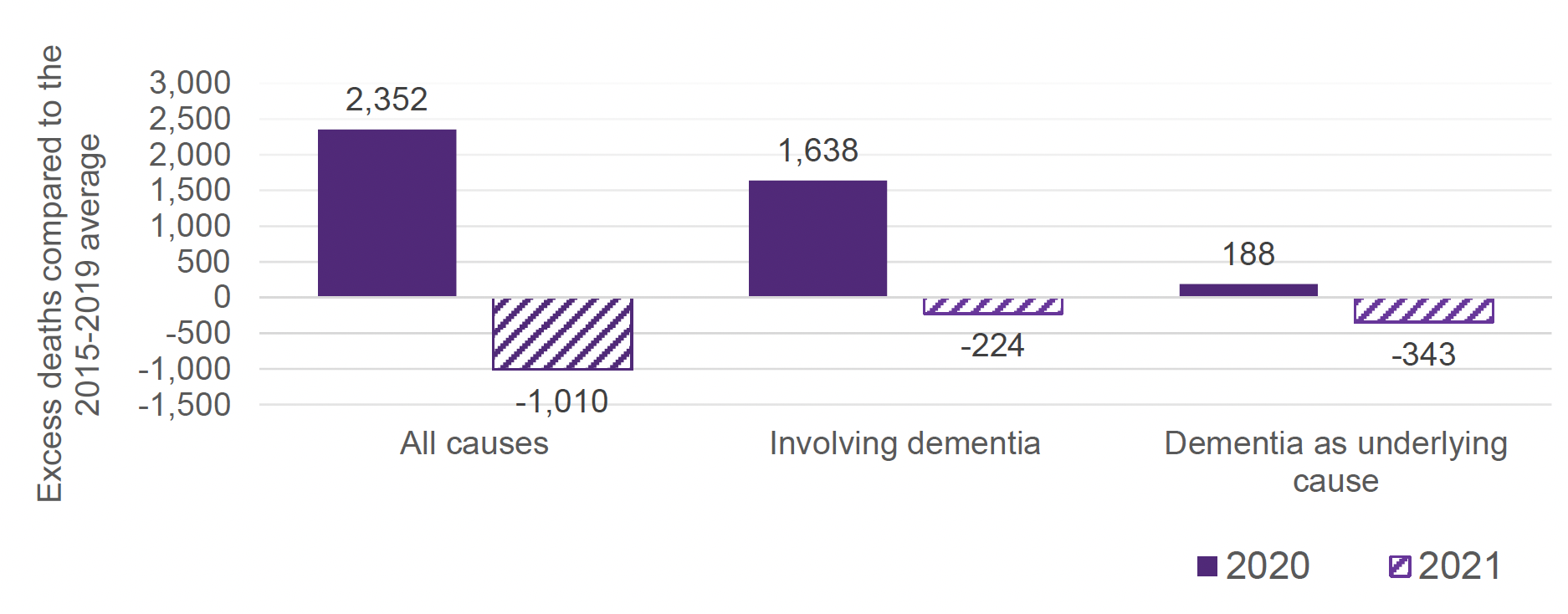Excess deaths from all causes, involving and with dementia as the underlying cause: Scotland 2020-2022
Secondary analysis of National Records of Scotland deaths data relating to people with dementia during the coronavirus (COVID-19) pandemic in different settings.
In care homes, deaths from all causes, involving dementia, and with dementia as the underlying cause reduced to below average levels in 2021

Deaths involving dementia and deaths with dementia as the underlying cause, compared with deaths from all causes, in care homes
In 2020, three quarters of excess deaths involving dementia occurred in care homes, a setting which has a high proportion of individuals diagnosed with dementia (estimated at 62% of residents in care homes for older people, see the Public Health Scotland Care Home Census 2022).
In 2020, there were 2,352 (+17%) excess deaths from all causes in care homes compared to the care home 2015-2019 average. Deaths involving dementia and deaths with dementia as the underlying cause also exceeded the average in 2020 with 1,638 (+26%) and 188 (+4%) excess deaths, respectively.
In 2021, there were 1,010 fewer (-7%) deaths from all causes in care homes compared to the care home 2015-2019 average. Deaths involving dementia and deaths with dementia as the underlying cause were below average in 2021 with -224 (-4%) and -343 (-8%) fewer deaths, respectively.
Deaths involving dementia and COVID-19, in care homes
In care homes, in 2020, the number of deaths involving dementia and COVID-19 (1,577) was similar to the number of excess deaths involving dementia in care homes (1,638).
In 2021, there were fewer deaths involving dementia and COVID-19 (530)compared to 2020, and deaths involving dementia (-224) were below average.
Changing care home occupancy
It is important to note that these figures are likely impacted by the high number of deaths that occurred in Spring 2020. This reduced the size of the care home resident population and care homes were subsequently under-occupied, and we would expect a lower number of deaths with reduced occupancy in 2021. Between 2011 and 2021, the estimated number of residents in care homes for older people decreased by 9%, from 33,645 to 30,502, and by 6% between 2019 and 2021, from 32,445 to 30,502 (see the Public Health Scotland Care Home Census 2021).
This decrease in care home occupancy has occurred in the context of a long-term reduction in the number of care home residents over the last decade despite a growing older population in Scotland, which may relate to a policy emphasis on supporting people to live independently in the community.
Alongside this observed trend, public awareness of the high level of excess deaths in care homes in the first wave of the pandemic may have affected decisions about whether to stay in a care home.
It is possible that both these factors influenced the level of care home occupancy in 2021.
Care home occupancy remained relatively stable between 2021 and 2022 with a small increase in the number of residents: there were 30,552 residents in care homes for older people on 31 March 2022 (see the Public Health Scotland Care Home Census 2022).
Contact
Email: CEU@gov.scot
There is a problem
Thanks for your feedback